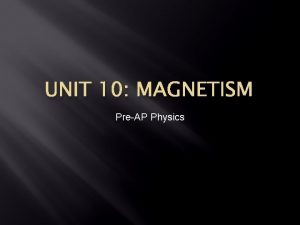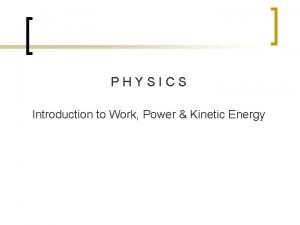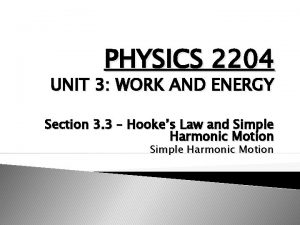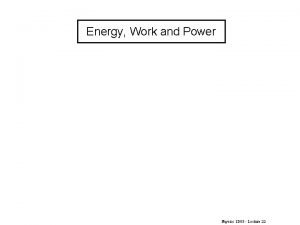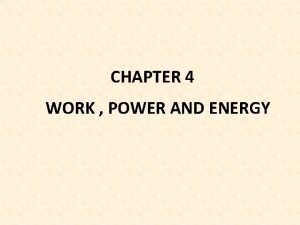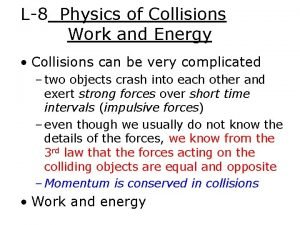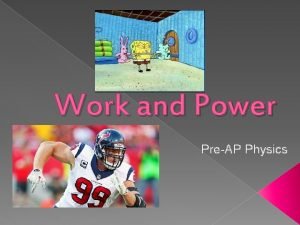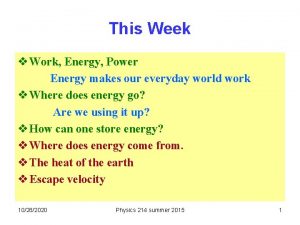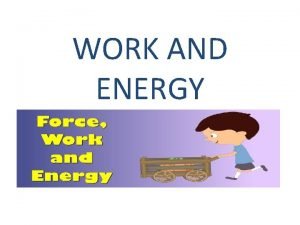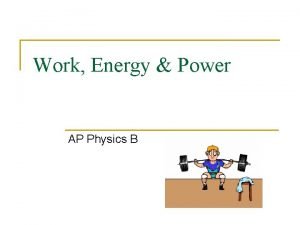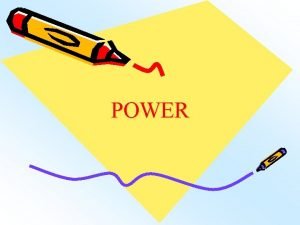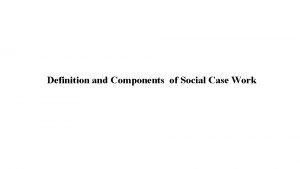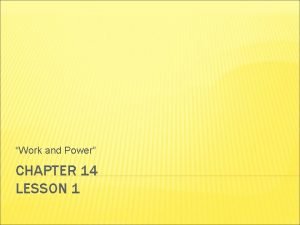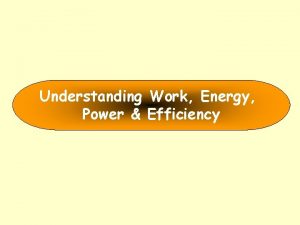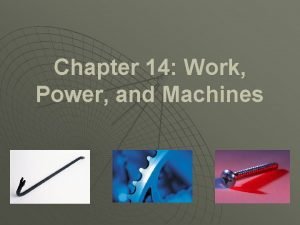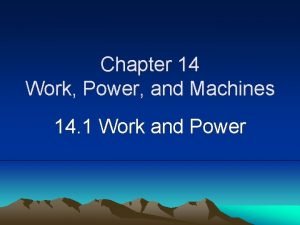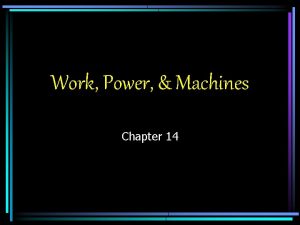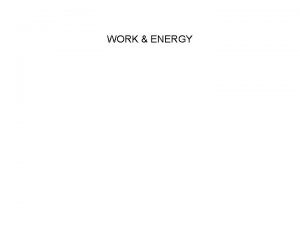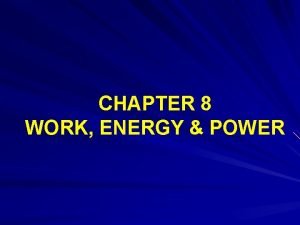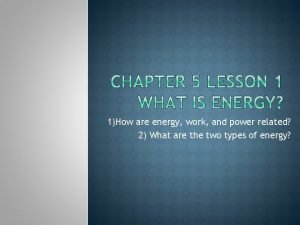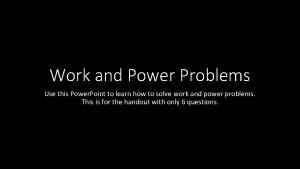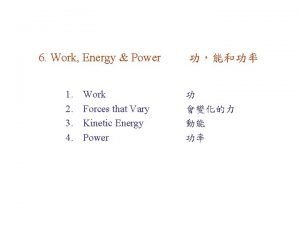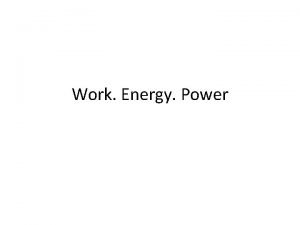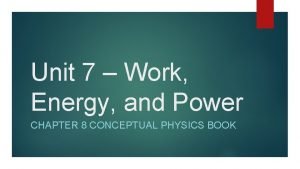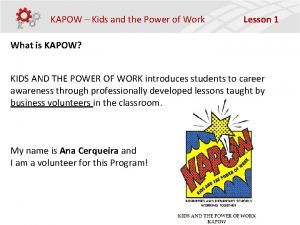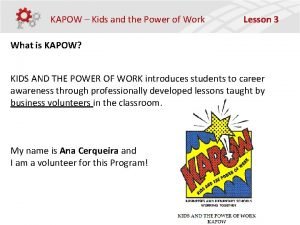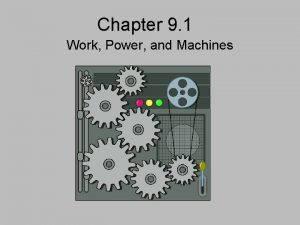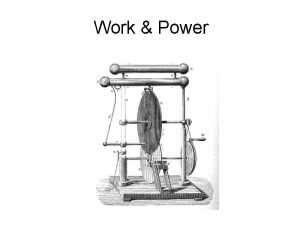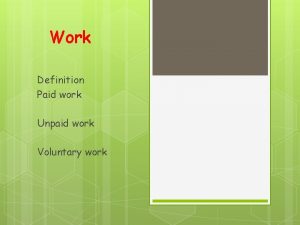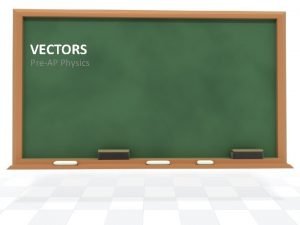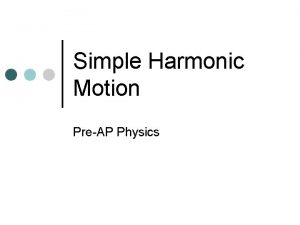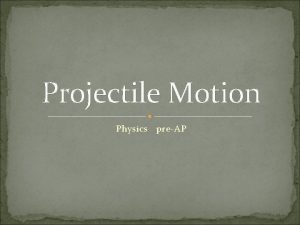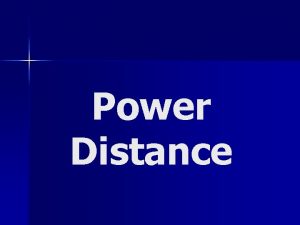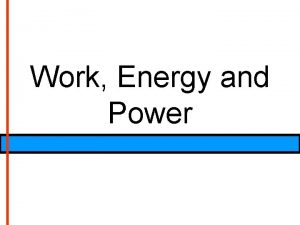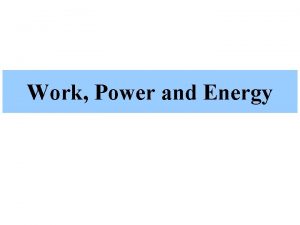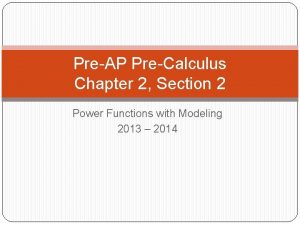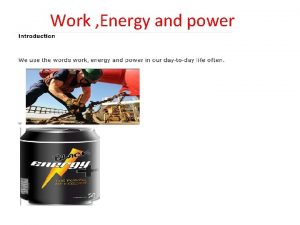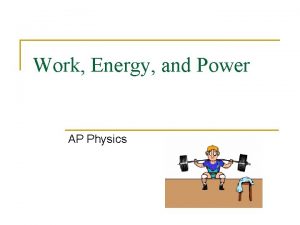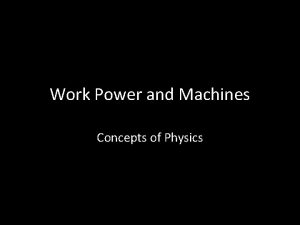Work and Power PreAP Physics Definition of Work




![The SI units W = joules (J) [or N ∙ m] 2 2 [or The SI units W = joules (J) [or N ∙ m] 2 2 [or](https://slidetodoc.com/presentation_image_h/2c4484ca8d65a15ff191d76683ab6ded/image-5.jpg)












































- Slides: 49

Work and Power Pre-AP Physics

Definition of Work is the force necessary to move an object a distance.

Work is only done by a force on an object if the force causes the object to move parallel the force. Objects that are at rest still have forces acting on them, but definitely no work is done if there is no movement.

Work Add to formula chart: Work = Force x distance W = Fd (If the force is parallel to distance traveled)
![The SI units W joules J or N m 2 2 or The SI units W = joules (J) [or N ∙ m] 2 2 [or](https://slidetodoc.com/presentation_image_h/2c4484ca8d65a15ff191d76683ab6ded/image-5.jpg)
The SI units W = joules (J) [or N ∙ m] 2 2 [or kg ∙ m /s ] F = Newtons (N) d = meters (m)

Two factors have to be considered when deciding if work is being done. . . Was a force applied? 2. Was there a change in distance caused by the applied force? 1.

In which case would you do more work? a. Lifting one book over your head b. Lifting 2 books over your head a. Holding two books over b. Lifting two books over your head a. Holding a stack of books and walking them to the counter b. Pushing a stack of books over to the counter

W=Fx If a man pushes a concrete block 10 meters with a force of 20 N, how much work has he done? Known: x = 10 m F = 20 N W = Fx (W = 20 N x 10 m) 200 joules 8

BUT, what happens if the force and the distance are …. NOT parallel to each other? Force Distance Force

If this is the case � We must find the component of the force that is parallel of the distance moved. F Work = Force x Distance x cosӨ F Need to Know Ө FcosӨ Distance

Add this equation to your formula sheet � You can always use the equation Work = (Force)(Distance)(cosӨ) W=FxcosӨ Force Ө = 0 o Displacement Cos 0 o = 1

What if it’s at an angle? � How much work is done on a vacuum cleaner pulled 3. 0 m by a force of 50. 0 N at an angle of 30. 0⁰? W = F(cos θ)x Known: Angle: 30⁰ X = 3. 0 m F = 50. 0 N W = 50. 0(cos 30) X 3. 0 W = 130 J

“Working” out A man benches 89 kg. The distance from his chest to the Top of the lift is 75 cm. Find the work done by the teacher for one rep (up and down). Known: distance (x) = 75 cm X 2 = 150 cm Fw = mg Force (weight lifted) = mg = 89 kg x 9. 8 m/s 2 = 872. 2 N W = Fx = (872. 2 N)(1. 5 m) = 1308. 3 J mg d. 5 FL

What is the unit of work? 1. 2. 3. 4. 5. Newton Meter Joule Newton meter 3 and 4

How much work is necessary to lift 10 kg 5 m in the air? 10 N 2. 50 J 3. 490 J 4. 4900 J 1. 10 kg 5 m

Power The rate at which work is done. à Rate of energy transfer by any method

Power Need to know Power is the rate at which work is done P = average power = work/time = W/t Unit: Watt(w) = Joule/sec (J/s)

Power Example: Running Stairs A 70 kg student runs up a flight of stairs in 4. 0 s. The vertical height of the stairs is 4. 5 m. Estimate the student’s power output in watts Know: mass = 70 kg; time = 4. 0 s; y = 4. 5 m The work is done against gravity: W= Force x distance; where force = mg And distance equals vertical distance y Work = (mass) x (gravity) x (y) W = (70 kg)(9. 8 m/s 2)(4. 5 m) W = 3087 Joules (J) P = Work/time P = 3087 J/ 4. 0 s P = 772 W (Recall 746 W = 1 hp) = 1. 03 hp mg y = 4. 5

How much power is required to lift 10 kg, 5 m in the air in 10 s? 49 w 2. 490 J 3. 490 w 4. 4900 w 1. 10 kg 5 m

Check for Understanding 1. Two physics students, Ben and Bonnie, are in the weightlifting room. Bonnie lifts the 50 kg barbell over head (approximately. 60 m) 10 times in one minute; Ben lifts the 50 kg barbell the same distance over his head 10 times in 10 seconds. Which student does the most work? Which student delivers the most power? Explain your answers. 20

Ben and Bonnie do the same amount of work; they apply the same force to lift the same barbell the same distance above their heads. Yet, Ben is the most powerful since he does the same work in less time. Power and time are inversely proportional. 21

How much power will it take to move a 10 kg mass at an acceleration of 2 m/s/s a distance of 10 meters in 5 seconds? Force=Mass x Acceleration Force=10 x 2 Force=20 N Work=Force x Distance Work = 20 x 10 Work = 200 Joules Power = Work/Time Power = 200/5 Power = 40 watts 22

Simple Machines The six simple machines are: � › › › Lever Wheel and Axle Pulley Inclined Plane Wedge Screw 23

Simple Machines �A machine is a device that helps make work easier to perform by accomplishing one or more of the following functions: › transferring a force from one place to another, › changing the direction of a force, › increasing the magnitude of a force, or › increasing the distance or speed of a force. 24

Mechanical Advantage � It is useful to think about a machine in terms of the input force (the force you apply) and the output force (force which is applied to the task). � When a machine takes a small input force and increases the magnitude of the output force, a mechanical advantage has been produced. 25

Mechanical Advantage Mechanical advantage is the ratio of output force divided by input force. If the output force is bigger than the input force, a machine has a mechanical advantage greater than one. � If a machine increases an input force of 10 pounds to an output force of 100 pounds, the machine has a mechanical advantage (MA) of 10. � In machines that increase distance instead of force, the MA is the ratio of the output distance and input distance. � MA = output/input � 26

No machine can increase both the magnitude and the distance of a force at the same time. 27

The Lever A lever is a rigid bar that rotates around a fixed point called the fulcrum. � The bar may be either straight or curved. � In use, a lever has both an effort (or applied) force and a load (resistant force). � 28

The 3 Classes of Levers � The class of a lever is determined by the location of the effort force and the load relative to the fulcrum. 29

To find the MA of a lever, divide the output force by the input force, or divide the length of the resistance arm by the length of the effort arm. 30

First Class Lever � In a first-class lever the fulcrum is located at some point between the effort and resistance forces. › Common examples of first-class levers include crowbars, scissors, pliers, tin snips and seesaws. › A first-class lever always changes the direction of force (I. e. a downward effort force on the lever results in an upward movement of the resistance force). 31

Fulcrum is between EF (effort) and RF (load) Effort moves farther than Resistance. Multiplies EF and changes its direction 32

Second Class Lever With a second-class lever, the load is located between the fulcrum and the effort force. � Common examples of second-class levers include nut crackers, wheel barrows, doors, and bottle openers. � A second-class lever does not change the direction of force. When the fulcrum is located closer to the load than to the effort force, an increase in force (mechanical advantage) results. � 33

RF (load) is between fulcrum and EF Effort moves farther than Resistance. Multiplies EF, but does not change its direction 34

Third Class Lever � With a third-class lever, the effort force is applied between the fulcrum and the resistance force. › Examples of third-class levers include tweezers, hammers, and shovels. › A third-class lever does not change the direction of force; third-class levers always produce a gain in speed and distance and a corresponding decrease in force. 35

EF is between fulcrum and RF (load) Does not multiply force Resistance moves farther than Effort. Multiplies the distance the effort force travels 36

Wheel and Axle The wheel and axle is a simple machine consisting of a large wheel rigidly secured to a smaller wheel or shaft, called an axle. � When either the wheel or axle turns, the other part also turns. One full revolution of either part causes one full revolution of the other part. � 37

Pulley � � � A pulley consists of a grooved wheel that turns freely in a frame called a block. A pulley can be used to simply change the direction of a force or to gain a mechanical advantage, depending on how the pulley is arranged. A pulley is said to be a fixed pulley if it does not rise or fall with the load being moved. A fixed pulley changes the direction of a force; however, it does not create a mechanical advantage. A moveable pulley rises and falls with the load that is being moved. A single moveable pulley creates a mechanical advantage; however, it does not change the direction of a force. The mechanical advantage of a moveable pulley is equal to the number of ropes that support the moveable pulley. 38

Inclined Plane � An inclined plane is an even sloping surface. The inclined plane makes it easier to move a weight from a lower to higher elevation. 39

Inclined Plane The mechanical advantage of an inclined plane is equal to the length of the slope divided by the height of the inclined plane. � While the inclined plane produces a mechanical advantage, it does so by increasing the distance through which the force must move. � 40

Although it takes less force for car A to get to the top of the ramp, all the cars do the same amount of work. A B C 41

Wedge � The wedge is a modification of the inclined plane. Wedges are used as either separating or holding devices. � A wedge can either be composed of one or two inclined planes. A double wedge can be thought of as two inclined planes joined together with their sloping surfaces outward. 42

Screw The screw is also a modified version of the inclined plane. � While this may be somewhat difficult to visualize, it may help to think of the threads of the screw as a type of circular ramp (or inclined plane). � 43

MA of an screw can be calculated by dividing the number of turns per inch. 44

Efficiency � We said that the input force times the distance equals the output force times distance, or: Input Force x Distance = Output Force x Distance However, some output force is lost due to friction. � The comparison of work input to work output is called efficiency. � No machine has 100 percent efficiency due to friction. 45

Practice Questions 1. Explain who is doing more work and why: a bricklayer carrying bricks and placing them on the wall of a building being constructed, or a project supervisor observing and recording the progress of the workers from an observation booth. 2. How much work is done in pushing an object 7. 0 m across a floor with a force of 50 N and then pushing it back to its original position? How much power is used if this work is done in 20 sec? 3. Using a single fixed pulley, how heavy a load could you lift? 46

Practice Questions 1. Explain who is doing more work and why: a bricklayer carrying bricks and placing them on the wall of a building being constructed, or a project supervisor observing and recording the progress of the workers from an observation booth. Work is defined as a force applied to an object, moving that object a distance in the direction of the applied force. The bricklayer is doing more work. 2. How much work is done in pushing an object 7. 0 m across a floor with a force of 50 N and then pushing it back to its original position? How much power is used if this work is done in 20 sec? Work = 7 m X 50 N X 2 = 700 N-m or J; Power = 700 N-m/20 sec = 35 W 3. Using a single fixed pulley, how heavy a load could you lift? Since a fixed pulley has a mechanical advantage of one, it will only change the direction of the force applied to it. You would be able to lift a load equal to your own weight, minus the negative effects of friction. 47

Practice Questions 4. Give an example of a machine in which friction is both an advantage and a disadvantage. 5. Why is it not possible to have a machine with 100% efficiency? 6. What is effort force? What is work input? Explain the relationship between effort force, effort distance, and work input. 48

Practice Questions 4. Give an example of a machine in which friction is both an advantage and a disadvantage. One answer might be the use of a car jack. Advantage of friction: It allows a car to be raised to a desired height without slipping. Disadvantage of friction: It reduces efficiency. 5. Why is it not possible to have a machine with 100% efficiency? Friction lowers the efficiency of a machine. Work output is always less than work input, so an actual machine cannot be 100% efficient. 6. What is effort force? What is work input? Explain the relationship between effort force, effort distance, and work input. The effort force is the force applied to a machine. Work input is the work done on a machine. The work input of a machine is equal to the effort force times the distance over which the effort force is exerted. 49
 Pre ap magnetism 1
Pre ap magnetism 1 Preap
Preap Physics 03-01 work and the work-energy theorem
Physics 03-01 work and the work-energy theorem The real lesson 21
The real lesson 21 0kei0
0kei0 Kinetic energy
Kinetic energy Work and energy
Work and energy Physics 2204 unit 3: work, power, energy
Physics 2204 unit 3: work, power, energy Definition of work power and energy
Definition of work power and energy Power formula physics
Power formula physics F d cos theta
F d cos theta Work and power definition
Work and power definition Fx=fcos
Fx=fcos Work physics definition
Work physics definition What is the definition of work in science
What is the definition of work in science Definition of work in physics
Definition of work in physics Krinal meaning
Krinal meaning Why does it happen
Why does it happen University physics with modern physics fifteenth edition
University physics with modern physics fifteenth edition Physics ia introduction
Physics ia introduction Solar power satellites and microwave power transmission
Solar power satellites and microwave power transmission Potential power
Potential power The dispersive power of a grating is defined as the
The dispersive power of a grating is defined as the F= ma units
F= ma units A slingshot consists of a light leather cup
A slingshot consists of a light leather cup Work and energy physics
Work and energy physics A 70 kg base runner
A 70 kg base runner Describe power in physics
Describe power in physics Components of social case work
Components of social case work Section 4 review physical science
Section 4 review physical science Work power and efficiency
Work power and efficiency Define work and power
Define work and power Chapter 14 section 1 work and power
Chapter 14 section 1 work and power How to calculate work and power
How to calculate work and power Chapter 14 work power and machines
Chapter 14 work power and machines Chapter 14 work power and machines
Chapter 14 work power and machines Chapter 14 work power and machines
Chapter 14 work power and machines Work, power and energy activities
Work, power and energy activities Chapter 8 work and power answers
Chapter 8 work and power answers How are energy work and power related
How are energy work and power related Sheila has just arrived at the airport and is dragging
Sheila has just arrived at the airport and is dragging Work power energy and machines
Work power energy and machines Work power and energy
Work power and energy Work energy theorem in words
Work energy theorem in words Unit 7 work energy and power answers
Unit 7 work energy and power answers Kapow kids
Kapow kids Kids and the power of work
Kids and the power of work A crate of bananas weighing 3000 n
A crate of bananas weighing 3000 n Flex power power supply
Flex power power supply Power of a power property
Power of a power property
